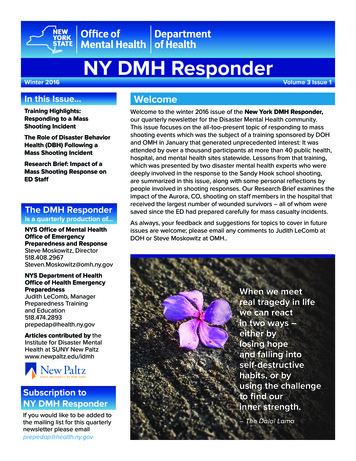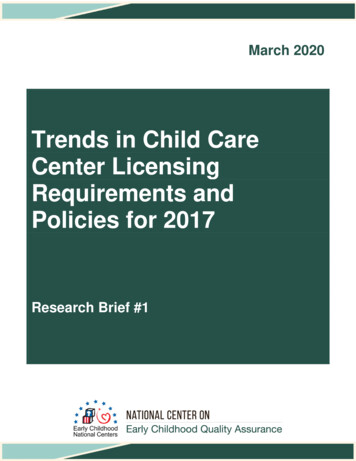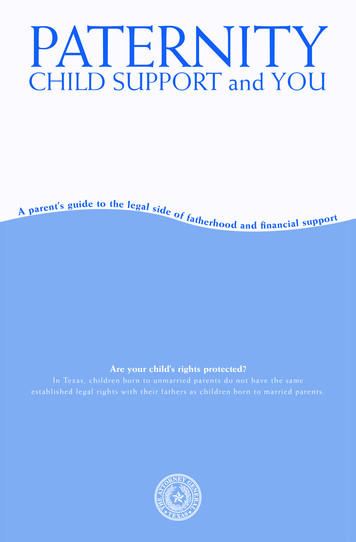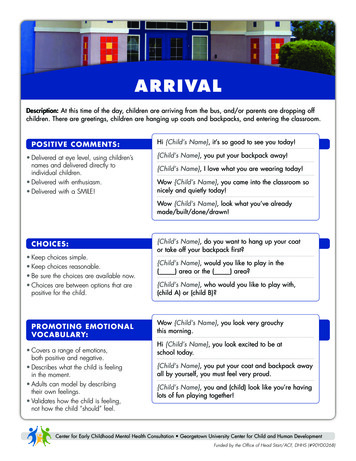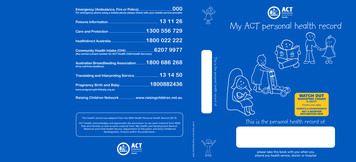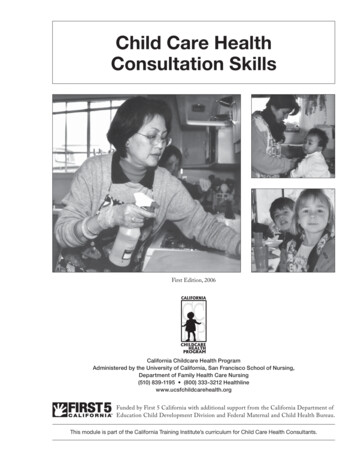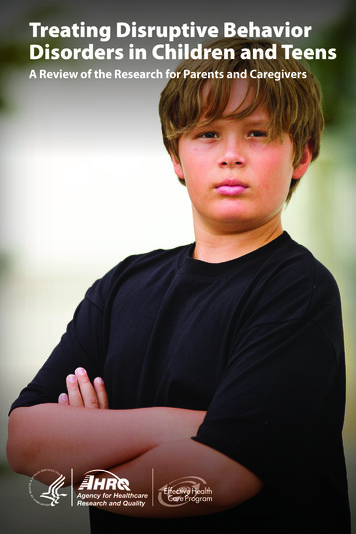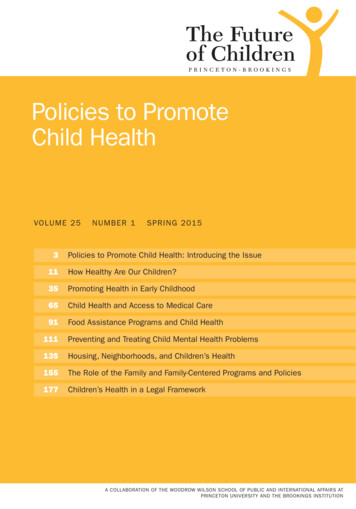
Transcription
Policies to PromoteChild HealthVO LUM E 2 53NUMBER 1SPRIN G 2015Policies to Promote Child Health: Introducing the Issue11How Healthy Are Our Children?35Promoting Health in Early Childhood65Child Health and Access to Medical Care91Food Assistance Programs and Child Health111Preventing and Treating Child Mental Health Problems135Housing, Neighborhoods, and Children’s Health155The Role of the Family and Family-Centered Programs and Policies177Children’s Health in a Legal FrameworkA COLLABORATION OF THE WOODROW WILSON SCHOOL OF PUBLIC AND INTERNATIONAL AFFAIRS ATPRINCETON UNIVERSITY AND THE BROOKINGS INSTITUTION
The Future of Children promotes effective policies and programs for children byproviding timely, objective information based on the best available research.Senior Editorial StaffJournal StaffSara McLanahanEditor-in-ChiefPrinceton UniversityDirector, Center for Research onChild Wellbeing, and William S. TodProfessor of Sociology and Public AffairsKris McDonaldAssociate EditorPrinceton UniversityJanet M. CurrieSenior EditorPrinceton UniversityDirector, Center for Health and Wellbeing;Chair, Department of Economics;and Henry Putnam Professor of Economicsand Public AffairsRon HaskinsSenior EditorBrookings InstitutionSenior Fellow, Cabot Family Chair, andCo-Director, Center on Children and FamiliesCecilia Elena RouseSenior EditorPrinceton UniversityDean, Woodrow Wilson School of Publicand International Affairs, Katzman-ErnstProfessor in the Economics of Education,and Professor of Economics and Public AffairsJon WallaceManaging EditorPrinceton UniversityLisa Markman-PithersOutreach DirectorPrinceton UniversityAssociate Director, EducationResearch SectionStephanie CenculaOutreach CoordinatorBrookings InstitutionRegina LeidyCommunications CoordinatorPrinceton UniversityTracy MeroneAdministratorPrinceton UniversityIsabel SawhillSenior EditorBrookings InstitutionSenior Fellow and Co-Director, Center onChildren and FamiliesThe Future of Children would like to thank the Robert Wood Johnson Foundation andthe Spitzer Family Foundation for their generous support.ISSN: 1054-8289ISBN: 978-0-9857863-3-5
VOLUME 25NUMBER 1SPRING 2015Policies to Promote Child Health3Policies to Promote Child Health: Introducing the Issueby Janet Currie and Nancy Reichman11How Healthy Are Our Children?by Sara Rosenbaum and Robert Blum35Promoting Health in Early Childhood by Maya Rossin-Slater65Child Health and Access to Medical Careby Lindsey Leininger and Helen Levy91Food Assistance Programs and Child Health by Craig Gundersen111Preventing and Treating Child Mental Health Problemsby Alison Cuellar135Housing, Neighborhoods, and Children’s Healthby Ingrid Gould Ellen and Sherry Glied155The Role of the Family and Family-Centered Programs and Policiesby Lawrence M. Berger and Sarah A. Font177Children’s Health in a Legal Frameworkby Clare Huntington and Elizabeth Scottwww.futureofchildren.org
Policies to Promote Child Health: Introducing the IssuePolicies to Promote Child Health:Introducing the IssueJanet Currie and Nancy ReichmanAlarge volume of high-qualityresearch shows that unhealthychildren grow up to beunhealthy adults, that poorhealth and low income go handin hand, and that the consequences of bothpoverty and poor health make large demandson public coffers. Thus promoting children’shealth is essential for improving the population’s health; policies to prevent children’shealth problems can be wise investments;and policy makers should implement carefully designed policies and programs topromote child health.According to the World Health Organization,health is a state of complete physical, mental, and social wellbeing, and not merelythe absence of disease or infirmity. We viewhealth in this broad sense, encompassingboth physical and mental health indicators.And because some children’s health problemsmay go undiagnosed or take years to becomeapparent, we also consider conditions thatpredict poor child health (such as low birthweight) and behaviors that affect health (suchas substance use).We view policies in a broad sense as well.Because an array of physical and socialfactors—including unsafe housing, pollution, food insecurity, and maltreatment,all of which are related to poverty—canadversely affect health, many types of policies are important for child health. Thus weconsider the effects of policies that don’tspecifically focus on health (such as cashor in-kind assistance, or parenting education programs) in addition to policies thatfocus on access to health care or the directprovision of medical services. Relevant policies come in many shapes and sizes, ranging from large federal programs such asHead Start and the Supplemental NutritionAssistance Program (SNAP) to more modest local public health initiatives.U.S. child health policy is thus a patchworkof efforts at the federal, state, and local levels. Many policies aim specifically to improvechild health, while others have differentgoals but could indirectly affect the health ofchildren. Some health-related policies targetchildren directly, attempting to treat healthproblems once they occur or to prevent themwww.futureofchildren.orgJanet Currie is the Henry Putnam Professor of Economics and Public Affairs, chair of the Department of Economics, and director of theCenter for Health and Wellbeing at Princeton University. Nancy Reichman is a professor of pediatrics at Rutgers University’s RobertWood Johnson Medical School and a visiting professor of economics at Princeton University.VOL. 25 / NO. 1 / S PR ING 20153
Janet Currie and Nancy Reichmanfrom occurring, while others target womenduring or before pregnancy with the goalof improving the health of newborns. Somepolicies target low-income children, whileothers are more universal.For this issue of The Future of Children, wecommissioned a group of experts to reviewresearch on how effectively U.S. policies promote child health. The articles, based on thestrongest evidence to date, assess how best topromote child health and, more specifically,what interventions and strategies work bestat various stages of children’s development.In the lead article, Sara Rosenbaum andRobert Blum paint a portrait of child healthin the United States today, setting it in itshistorical, national, and international context. Maya Rossin-Slater reviews programsto promote child health at birth and in theearly childhood years. Craig Gundersen,Ingrid Gould Ellen and Sherry Glied, andLindsey Leininger and Helen Levy reviewpolicies that provide food, housing, andaccess to health care, respectively, examining how those policies impact child health.Lawrence Berger and Sarah Font considerpolicies that focus on families, viewedthrough a child health lens. Alison Cuellarfocuses on children’s mental health andreviews policies in that important area.Finally, Clare Huntington and ElizabethScott provide important context vis-à-vis thelegal framework that both shapes and constrains U.S. policies to promote child health.Themes of the IssueFive broad, overlapping themes emerge fromthis issue: A wide range of policies are important forpromoting child health;4T H E F U T UR E OF C HI L DRE N Responsibility for promoting child healthis fragmented, with a lack of consensusabout government’s appropriate role; We have a “crisis response” mentality thatdoesn’t focus on prevention and oftenprecludes implementing policies in waysthat would let us thoughtfully evaluatetheir efficacy; Information about cost-effectiveness isseverely lacking; and Poor and minority children typically facethe greatest health risks.A Wide Range of PoliciesWe can’t think exclusively about health carewhen considering policies to promote childhealth. Access to preventive, curative, andpalliative medical care is no doubt important, but many other types of policy matteras well. A century ago, as Rosenbaum andBlum show, infectious diseases posed theprimary threat to children’s health. As thatthreat has diminished, others have come tothe fore. Many of the most important threatsto child health today have to do with thesocial and physical environment, broadlydefined. For example, injury is now theleading cause of death among children overone year old. Policies to prevent injury rangefrom housing and traffic ordinances to familyinterventions to prevent child abuse. Suicidehas become a major cause of death amongadolescents. Policies that focus on children’smental health range from behavioral interventions in schools to rehabilitative mentalhealth treatment in the juvenile justice system. Whether we are thinking of infectiousdisease or any other threats to child health,parental education and income are amongthe most important protective factors. Thus,a wide range of antipoverty programs mayalso improve children’s health and help themreach their full potential.
Policies to Promote Child Health: Introducing the IssueFragmented ResponsibilityLimited Data on Cost EffectivenessA serious obstacle to improving U.S. children’s health is the fragmentation of responsibility between families and multiple layersof government. Huntington and Scott highlight a uniquely American tension betweenthe idea that child health is primarily afamily responsibility and the view thatgovernment has a responsibility to ensurethe health of its most vulnerable citizens. Inthe United States, unlike in other developedcountries, the government has no affirmative obligation to promote child health and,more often than not, steps in only aftera severe health risk has been identified.Moreover, responsibility is fragmentedat the federal, state, and local levels, andamong entities that control different aspectsof children’s welfare, such as health care,education, and juvenile justice. The result isa largely uncoordinated jumble of resourcesand services that can be extremely difficultto navigate and within which children wholive in different places or situations havevery different access to resources.Unfortunately, the fragmentation of children’s health care services and resources inthe United States, combined with a crisisresponse approach to child health, hasproduced an inefficient system. Moreover,because this fragmentation results in a lackof data about the cost effectiveness of various interventions and policies, it’s hard tomake informed policy choices. We suspectthat, for many dimensions of child health, anounce of prevention would be worth a poundof cure, but it’s difficult to prove this withouthard evidence on the costs and benefits ofdifferent approaches.Crisis Response MentalityParents’ rights to raise their children asthey see fit, along with the U.S. government’s limited responsibility for promotingchildren’s health and the fragmentationof services under federalism, has led bydefault to a system that tends to respondto crises rather than marshaling resourcesto promote child health. Many incipientchildren’s health conditions, particularlymental health problems, are acknowledgedor treated only after they produce seriousadverse private or public consequences,such as academic failure, family disintegration, or school violence. This Band-Aidapproach makes it hard to develop a coherent strategy for preventing children’s healthproblems and for evaluating the effectiveness of efforts to do so.Poor and Minority ChildrenVirtually all of the articles in this issuehighlight the fact that poor and minority children face disproportionate threatsto health. Rossin-Slater points out thathealth disadvantages start before birth andare reflected in socioeconomic and racialdisparities in low birth weight and infantdeath. And the effects of socioeconomicdisadvantage accumulate over time: Poorand minority children are more likely toexperience conditions that can harm theirhealth, such as poor nutrition, pollution,and substandard housing. Disadvantagedchildren are also more likely to be maltreated and more likely to become wards ofthe foster care system or end up in juveniledetention. Many of the policies covered inthis issue focus on disadvantaged childrenand thus have the potential to reducehealth disparities.Findings of the IssueHere we highlight key findings from theindividual articles.VOL. 25 / NO. 1 / S PR ING 20155
Janet Currie and Nancy ReichmanHow Healthy Are Our Children?Rosenbaum and Blum survey long-termtrends in child health. In terms of mortality, child health in the United Stateshas been improving steadily for a longtime. This improvement no doubt reflectsadvances in medical care, such as neonatal care technology and immunizations forkiller diseases such as measles and polio, aswell as substantial improvements in livingstandards over the course of the twentiethcentury. But it also reflects the many policies implemented to ensure that childrenbenefit from these advances, showing thatpolicy has been, and can be, effective. Thatsaid, substantial racial and socioeconomicdisparities in infant and child mortality persist, pointing to a continuing role for publicpolicy. Finally, the overall increases in childsurvival have led to an increased focus onchildren’s illnesses. Obesity, asthma, andmental health disorders (and disparities inmany of these conditions) are among the keychild health concerns today.Rosenbaum and Blum also tackle the thornyissue of government spending on children’shealth relative to spending on other groups,particularly the elderly. They point out thatspending on child health has increasedover time, but that the largest share of theincreased spending over the past century hasbeen for health care, while spending on otherdeterminants of child health, which may beas or more important, has not kept pace.Promoting Health in Early ChildhoodMany child health problems start early inlife, in utero, or perhaps even before mothers conceive. Rossin-Slater discusses theevidence for, and provides an overviewof, policies aimed at pregnancy and earlychildhood. She finds little evidence that6T H E F U T UR E OF C HI L DRE Nincreasing the availability of prenatal carewould produce large improvements in childhealth, perhaps because such care is alreadywidely available. In contrast, other effortsshow more promise, such as nurse homevisiting programs and the SupplementalNutrition Program for Women, Infants,and Children (WIC), both of which involveimproved access to prenatal care but havebroader scope. Rossin-Slater demonstratesthat relatively subtle differences betweenprograms (such as the type of visitor ina home visiting program) may have largeimpacts on their effectiveness, underscoringthe need for attention and fidelity to program design and careful evaluation of theevidence.Child Health and Access toMedical CareOne reason that we need to think beyondaccess to medical care is that even thoughpublic policy has improved such access forchildren over the past 20 to 30 years, children’s health and health disparities remainsignificant concerns. Leininger and Levyshow that Medicaid and the Child HealthInsurance Program have been the primaryvehicles for expanding health insurancecoverage among disadvantaged populationsand that these programs now cover millions of pregnant women and children. TheAffordable Care Act may increase accessto and reliance on private insurers throughstate health insurance exchanges, but mayalso complicate children’s access to care.They conclude that a range of policies couldfurther expand access. Some of these wouldaffect families’ use of the care availablefor their children, and others would affectproviders’ willingness to supply care to poorchildren. However, they conclude, the available evidence can’t tell us which policieswould have the most “bang for the buck,”
Policies to Promote Child Health: Introducing the Issueand we need more information about barriers to care among eligible children and thequality of care they receive.Food Assistance Programs andChild HealthU.S. food and nutrition programs weredeveloped in response to child hunger, butthey now exist in a world where childhoodobesity and related diseases are increasinglyprevalent. Yet many children still suffernutrient deficiencies and food insecurity.Focusing on the largest nutrition programs,including SNAP and school meal programs,Gundersen presents abundant evidence thatthese programs reduce children’s food insecurity, which is related to both poverty andhealth. However, many controversies remain,such as whether restricting what can be purchased through SNAP would be beneficial orharmful, and whether SNAP benefits are toolow or, in some cases, too high.Preventing and Treating Child MentalHealth ProblemsMental health problems have surpassedphysical health problems to become themost prevalent and disabling conditions facing children today. Cuellar discusses some ofthe most common and serious mental healthconditions, including ADHD and autism.This article brings the issue of fragmentation of services to the fore. Though mentalhealth conditions can be treated in a healthcare setting, for many families the first pointof contact and the setting for intervention istheir children’s schools. For both legal andinstitutional reasons, cooperation betweenchildren’s health care and education providers can be extremely difficult, and childrenwho “age out” or drop out of school may findthemselves with nowhere to go for servicesor guidance. That said, the fragmentedsystem presents an opportunity for policymakers to use existing resources to create acoordinated mental health care delivery system for children. Cuellar also highlights thedearth of good evidence about the costs andbenefits of many treatment approaches. Thislack of evidence means that parents find itextremely challenging to find solid information about whether an intervention is likelyto be effective for their children, and policymakers find it hard to strategically invest inspecific interventions to enhance children’smental health.Housing, Neighborhoods, andChildren’s HealthChildren’s housing situations are associated with an array of factors that couldpotentially affect their health—for example,exposure to lead paint, air pollution, anddangerous physical structures, as well asproximity to resources such as health-careproviders, child care facilities, and schools.Ellen and Glied review what’s known abouthow children’s residential living situationsaffect their physical and mental health andhow programs and policies such as public housing, certificates and vouchers, andlow-income housing tax credits play a role.They show that vouchers or subsidies tomake housing more affordable for targetedfamilies may drive up rents, meaning that assome families benefit, others fall behind—anunintended effect that can make it difficultto measure the effects of interventions.The Role of the Family and FamilyCentered Programs and PoliciesFamilies play a crucial role as children’sguardians and advocates and make decisions every day that affect their children’shealth. When things go wrong, familiescan also injure and even kill their children.Berger and Font review important policiesand programs that affect the role of parents,VOL. 25 / NO. 1 / S PR ING 20157
Janet Currie and Nancy Reichmanincluding the child welfare system andinterventions to improve parenting practices.They conclude that Child Protective Services(CPS), in particular, is limited by its reactive nature; CPS generally does not becomeinvolved in a child’s life until damage hasalready been done. They also review communitywide programs, such as the DurhamFamily Initiative and the Triple P—PositiveParenting Program, that aim to improveparenting and prevent maltreatment beforeit starts through comprehensive supportto families at risk. Though the scope andexpense of these programs unfortunately discourages their wide adoption, the evidencesuggests that identifying and adopting theirmost successful elements could have beneficial effects. Berger and Font also argue thatincreasing parents’ access to mental healthservices could be a promising strategy forpromoting children’s health.Children’s Health in a LegalFrameworkPolicy exists in a particular legal context.Huntington and Scott provide importantperspective by describing our legal framework as it pertains to child health. In oursystem, which is based on parental rights,the state has the power to limit parentalauthority but has not created any affirmativelegal obligation to assist parents in caringfor their children’s health needs. In fact,deference to parents may deter the statefrom acting and contributes to the tendencyto react to crises rather than to adopt moreproactive policies. The authors outline theparental rights doctrine under constitutionaland statutory law and explore the limits ofparental rights. They focus on examples inwhich parents’ religious beliefs prevent themfrom seeking health care for their children,as well as on the more general topic ofadolescent health policy—an area where8T H E F U T UR E OF C HI L DRE Nthe law sometimes departs from the parental rights approach, particularly in matterssuch as reproductive health and servicesfor delinquent youth. Although Huntingtonand Scott don’t cover it in detail, refusingvaccines is an area in which parental rightsare being challenged. Unlike withholdingmedical treatment for religious reasons,parents’ refusals to allow children to receiverecommended vaccines can affect the healthof children other than their own, and havebeen blamed for recent outbreaks of measlesand other contagious diseases that untilrecently had been all but eradicated in theUnited States.Implications for Researchand PolicyThe five themes of this issue lead naturallyto recommendations for researchers andpolicy makers. Most importantly, we mustview health and health policy broadly, andconsider policies beyond those that focusnarrowly on access to health care. An important example is the increasing relative importance of mental health disorders. Healthpolicy today should devote more resources topreventing, diagnosing, and managing theseconditions to improve children’s functioningand trajectories.Second, the fragmented nature of responsibility for child health and health policyhas produced a chronic lack of coordination among different actors and levels ofgovernment. This systemic disarray makesit more likely that children will fall throughthe cracks and predisposes us to take acrisis-oriented stance rather than a proactive approach to health policy. Businessesroutinely track customer data for marketingpurposes and planning, but governmentshave not made the same use of the “big
Policies to Promote Child Health: Introducing the Issuedata” at their disposal to create an integratedportrait of child health or to target policiesto those who have the most to gain fromthem. Systems that effectively increase coordination among the home, doctors’ offices,schools, and other institutions that touchchildren’s lives would tremendously benefitefforts to promote child health.Third, although all levels of government havebeen implementing a wide array of policies,they have paid remarkably little attention torigorous evaluation, or even to documentingexactly what elements the programs involve.While some major programs have beenproven to promote child health, we have toolittle information to systematically comparedifferent approaches. Thus it’s difficult toanswer the most basic and obvious questionfacing policy makers: What are the mostcost-effective ways to promote child health?That said, this issue of The Future ofChildren points to numerous programs thatwork. And for some of them, well-designedevaluations have shown that their benefitsexceed their costs. These include nationalprograms such as WIC, state and localefforts such as home visiting programs, andvery specific local programs such as mandating window guards on high-rise apartmentbuildings. The fact that we can’t compareall policies shouldn’t keep us from implementing or expanding those we know tobe both effective and cost saving and fromevaluating others that show promise. Also,while many policies and evaluations focuson young children, a number of interventions for adolescents have been shown to beeffective—for example, programs that targetviolence and teen pregnancy. Hence olderchildren should not be overlooked in effortsto promote child health.Fourth, given the disproportionate burdenof ill health that they face, poor and minority children deserve special attention. Weshould consider the fact that the same policies may have different impacts on differentgroups. In some cases, such as housing subsidies that have the unintended effect of raising rents, the overall effect may actually benegative for the most disadvantaged groups(in this example, those who are not able tonavigate the system and obtain the subsidies). The possibility that poor and minoritychildren are in double jeopardy—both morelikely to have health risks and more likelyto be harmed by policies meant to assistthem—merits more attention. Similarly, weshould look further at whether expandinghealth insurance for higher-income childrenresults in reducing access for the most disadvantaged children, or whether attempts toimprove the nutritional content of programslike the National School Lunch Programmight lead some children to stop participating altogether.Finally, we should keep in mind that investments in child health have the potential torepay current expenditures many times over,both by allowing children to grow up to beproductive citizens and by improving thecircumstances of the next generation. Thearticles in this issue highlight many programs and policies—in the areas of healthcare, behavioral health, child development,nutrition, housing, income, and family functioning—that promise to pay such dividends.VOL. 25 / NO. 1 / S PR ING 20159
How Healthy Are Our Children?How Healthy Are Our Children?Sara Rosenbaum and Robert BlumSummaryThe past century has seen vast improvements in our children’s health. The infectious diseasesthat once killed huge numbers of children have largely been conquered. Infant mortality hasalso fallen markedly, although the United States lags behind other industrialized nations inthis and other measures of children’s health. Accidents and injuries also kill fewer childrenthan they once did.Today, write Sara Rosenbaum and Robert Blum, the greatest threats to U.S. children’s healthare social and environmental conditions, such as stress and exposure to toxic substances, whichare associated with noncommunicable illnesses, such as mental health problems and asthma.Unlike the communicable diseases of the past, these are not equal-opportunity hazards. Theyare far more likely to affect poor children and the children of racial and ethnic minorities. Andthey have long-lasting effects, both for individuals and for the nation. For example, people whoexperience unhealthy levels of stress as children grow up to become less healthy, less productive adults.Rosenbaum and Blum also examine government spending on children’s health. Though suchspending has increased over time, the largest share of that increased spending has been forhealth care, while spending on other determinants of child health, which may be as or moreimportant, has not kept pace. Investments in medical care alone can’t overcome social andenvironmental threats to children’s health that have their roots in historic levels of poverty andinequality. Rosenbaum and Blum argue that the best way to promote children’s health todayis to mitigate poverty, invest in education, and make our neighborhoods and communitieshealthier and safer.www.futureofchildren.orgSara Rosenbaum is the Harold and Jane Hirsh Professor of Health Law and Policy at the Milken Institute School of Public Health,George Washington University. Robert Blum is a professor and the William H. Gates Sr. Chair of the Department of Population, Family,and Reproductive Health at the Bloomberg School of Public Health, Johns Hopkins University. Rosenbaum thanks Carla Hurt forassistance with tables and figures. Blum thanks Laura Covarrubis for identifying child health data and Alex Blum for feedback on themanuscript draft.Julien Teitler of Columbia University reviewed and critiqued a draft of this article.VOL. 25 / NO. 1 / S PR ING 201511
Sara Rosenbaum and Robert BlumThis article presents an overview of the health of America’schildren and examines therole and extent of governmentinvestments in child health. Inbrief, we find that despite major gains overthe past century, children’s health varieswidely across population subgroups and lagswell behind that of many other industrialized nations. Furthermore, although publichealth-care expenditures for children havegrown steadily, this growth has come fromexpanded eligibility for publicly financedhealth insurance and substantial increases inthe cost of health care. Rising health expenditures have coincided with the erosion ofpublic investment in education, housing, andsocial services, all of which are thought toaffect health, especially among the poorestchildren.U.S. children’s health today is best understood in the context of how child health hasevolved over the past century. Evidence overtime illuminates the social, behavioral, andeconomic factors that help explain both thenation’s accomplishments and its existing andemerging challenges.Where government investment in childhealth is concerned, we must explore a broadrange of expenditure trends, since virtuallyall government policies can affect children’shealth. These include both tax expendituresand direct investments across the areas ofincome support, education, social services,housing, community development, nationalinfrastructure, public health, and healthcare. One reason we must view governmentspending broadly is that direct investment inother populations can have spillover effectson children. For example, spending on theelderly, though frequently contrasted with12T H E F UT UR E OF C HI LDRE Nspending on children, could help childrenby easing their fa
VOLUME 25 NUMBER 1 SPRING 2015 Policies to Promote . To purchase a print copy, download free electronic copies, or sign up for our e-newsletter, go to our website, www.futureofchildren.org. . 35 Promoting Health in Early Childhood by Maya Rossin-Slater 65 Child Health and Access to Medical Care
